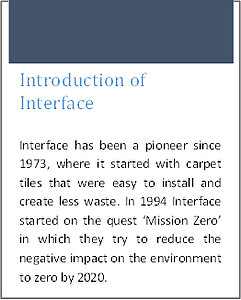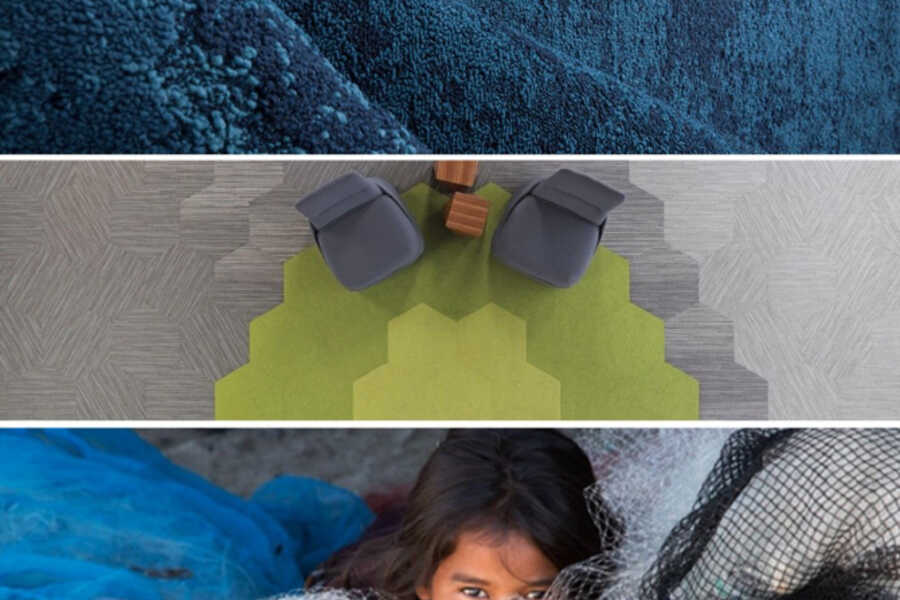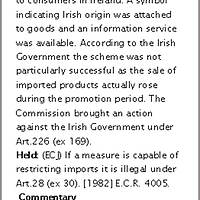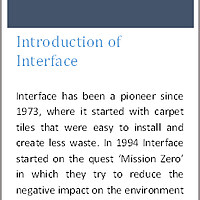Excursion to Interface with a presentation and discussion with ms. van Arkel.

On the 5th of December 2014 Interface was visited in Scherpenzeel to witness a presentation of Geanne van Arkel on how Interface puts sustainability into practice. This section summarizes information given during the presentation and gives more information on the additional questions which were asked during the discussion about implementing sustainability in practice.
Interface’s strategy for implementing sustainability: Bio-mimicry and the natural step
In order to reach the goal in 2020 Interface combines the strategy bio-mimicry and The Natural Step. While Bio-mimicry is used as an inspiration tool for designing processes, products and services, the Natural step is used as an implementation guide.
Geanne van Arkel, sustainability manager of Interface, states it is important to have high ambitions. Companies are often seduced to set a save target which they are sure off they can reach. Although others said it was impossible, since carpet tiles were made of oil, Interface now sets an example for how companies can be sustainable. ‘Success is not reaching your target; it is reaching the full possibilities’.
Interface started by analyzing their current state in 1994 concerning sustainability. From that moment Interface has always looked for ways to get to the target as close as possible and determine the next steps by back-casting to prevent they are limited by knowledge of today. Implementing sustainability asks for a proactive attitude to find solutions and the right partnerships to make it happen. It means you have to connect ideas between different stakeholders at the right time. Some ideas that have been ignored in the past may be suitable now. If you keep searching, the right partnerships will come on your path.
Most important activities to make a successful transition: Co-innovation and intrapreneurship
The most important two activities are co-innovation and intrapreneurship. Co-innovation means creating sustainable ideas together with partners and suppliers. You have to build on each other’s expertise. ‘Implementing sustainable solutions is not a marathon, it is a relay’. The small cycles in closed loop systems from re-use to refurbishment offer the most business opportunities. In the past, Interface used internal employees for a cleaning and installation service. By entering this field, partners and suppliers felt neglected since Interface was moving in their territory. In the present, Interface always seeks for co-creation with the supply chain to create sustainable business models that provide long term benefits. For the Net Works program Interface co-operated with a NGO for research on the social impact of discarded fishing nets in the sea and used their contacts to implement the Net Effect project in the Philippines. ‘In fact it is not a circular economy, but a relation economy. Relations are the most important thing for implementing sustainability’.
For Interface intrapreneurship means engaging your employees in the higher purpose of having zero negative environmental impact in 2020. The internal ‘Fast forward towards 2020’ program stimulates employees to think about how their role in the company can contribute to innovation and sustainability. ‘Everyone can contribute to innovation and sustainability, and you need everyone to contribute to solve something as complex as sustainability’. Even at the manufacturing site there are posters that remind employees to think about sustainability. ‘Some companies have teambuilding activities, we engage our employees in reaching a higher purpose. This makes it feel like a family company’.
How does Interface gets stakeholders along?
Like nature, Interface tries to implement diversity to make sustainability happen. Interface sees reaching their goal, as climbing a mountain. There are several paths to reach the top, but you do not know which path is the best one. Interface therefore searches for more solutions to stimulate suppliers to grow along as well. For example, Interface found a way to use 50% less yarn. They asked the yarn supplier what they could do to become more sustainable or Interface was obligated to move to another supplier. The supplier was stimulated to come up with a yarn that exists of 90% recycled material. The problem was that the recycled material stream was not enough for continuous production. By communicating this to Interface, Interface searched for a solution which made them come up with using discarded nylon 6 fishing nets in the oceans. The supplier now uses their own waste, recycled material and fishing nets for the yarn Interface makes carpet tiles of. By being open about your challenges and problems you stimulate stakeholders to search for solutions as well and create circumstances for co-creation. With this it is important to add value to all involved stakeholders to make sustainability happen. Sustainability can finance itself. Eliminating waste means savings costs, this leads to more profit. If this profit is invested in making products more sustainable, stories arise which will attract clients and suppliers. ‘Sustainability means creating value’.
What does Interface considers as catalyzers to implement sustainability
Some of the suppliers were touched by the vision of Ray Anderson in 1994, which made them grow along with Interface. A lot of sales to clients are triggered by the stories behind the products concerning sustainability. People appreciate honesty and persistence to reach a goal. Interface even tells their clients it is cheaper to reuse carpet tiles instead of buying new ones. Although it seems like it contradicts their sales, it is the right thing to do since it is more sustainable and these clients become ambassadors for life since Interface has saved them costs. Each ambassador attracts ten new other clients through mouth on mouth promotion.
Interview with ms. Saanen

The second interview we performed was by interviewing ms. Saanen, teacher of the section Policy, Organisation, Law and Gaming at TPM. She has a background in law and specializes in European Law. She gave a lecture in week 4 about legal tools to stimulate sustainability. We asked her about how she would approach the sustainability transition from a point of view of the law. The text below is a summary and translation of the interview.
The first question was about policy. Students have a lot of great visions on how sustainability should work in society, but this often requires an alteration in the way certain companies or civilians execute their businesses/daily lives. For instance, we require the civilians of Texel to increase their waste separation rate. The first question was therefore: What kind of policy, other than subsidies, are there to stimulate sustainable practices for persons and companies?
“There are multiple things that can be done. The government could for instance think about applying certain (sustainable) criteria when a call for tender is opened, to heighten the level of sustainability of projects that are executed with government money. Also, the origin of the locally produced products can be made transparent, e.g. by a “sustainably made in Texel” sticker. Since it only indicates the origin of the product (and a characteristic), without - in any way – explicitly stimulating the buying of especially these products, this is allowed by European law. It falls within the boundaries as set by the “Buy Irish” case which is explained in the textbox. In that case, a 3 years national campaign, organized by the government, to (openly) stimulate consumers to buy Irish products, was considered a violation of EU law, because it was explicitly aimed at replacing non-domestic products with domestic products, thereby restricting the free movement of goods. A sticker that indicates the local origin and the sustainable footprint contains merely a reference to the location of production and the way it was produced.
This could be combined with an educational campaign aimed at sustainable behavior of Texel inhabitants or companies. Educational campaigns are the third possibility for the stimulation of sustainable practices.
The second question was about closed loops in subsystems and how to achieve this from a law and policy perspective. A lot of the subsystems that are designed by me and my fellow students have as goal to create closed loops, for instance by collecting the coffee waste from the hospitality industry, which can be used to grow shiitake mushrooms, which can be sold back to the hospitality industry. If you had to think about implementing such systems, how would you start from a policy and law point of view?
The first principle is that you cannot, as a local government, oblige anyone to separate waste, or close loops for that matter. Therefore, you will have to look for other methods and the key principle will probably be to make it as easy as possible for the inhabitants to perform your preferred actions. You could think for instance about subsidizing certain behavior. The example of closing loops is hard to regulate since I imagine that there have to be private instances that will close these loops and thus it is a matter of contracts between these instances that will enable the loops to work. A way to kickstart these kind of initiatives would be with subsidies. If the beneficiary is a company, you have to be aware of the state aid rules, but there are many possibilities for (small scale) sustainable projects.
Our personal aim is to increase the waste separation rate on the island of Texel. If you had to design policy to increase this separation rate, what would be your approach?
I would refer to my earlier answer that the barriers for inhabitants to separate waste should be very low. An interesting example is the case of Austria where collectable garbage bags for separated waste are available for free, while collectable garbage bags for unseparated waste cost money.
On top of the “easiness”, inhabitants should understand why these actions are preferred and transparency is therefore very important. In your example of coffee waste; explain what happens with the coffee waste after it has been collected.
Could the profit of the waste sales be used to lower waste taxes?
No, I don’t think so because this is regulated on a higher level, so it is not within the competence of the Texel authorities to lower these taxes. The profits would end up in the general funds of the Texel government though. Therefore, it could be used by the Texel government to provide something for the inhabitants or companies of Texel. It would be good to be transparent about such money flows.
To conclude this interview, could you give your opinion on the role of governments and businesses in the sustainability transitions? To what extend should the transition be regulated in your opinion?
Of course, on EU level a lot of sustainable requirements are already set. And more will come. So the transition is already being regulated in that sense. Currently, many changes are ongoing in the public and corporate opinion on the ethics of business and daily lives. This is reflected for instance in the field of corporate sustainable responsibility (CSR) in which almost all major companies participate. However, there is still a lot of questionable behavior by companies, for instance the fact that they pay almost no taxes in The Netherlands while they are using the public goods (like our roads) that are financed with these taxes. There is a trend that this is becoming less acceptable. So if you ask me to what extend the transition should be regulated, I believe that there is first a need for change in the moral compass of companies. This could be reached if an ethical/sustainable image is valued by the public. The ISO-certification for Social Responsibility acknowledgement is a good start and could stimulate companies to follow these guidelines. You can try to influence the sentiments in the public and force companies to improve their transparency. So the regulation of transparency is a good option. An example of how transparency can drive change can be found in the Patagonia company example whose case is described here(PDF).
What can we learn from this for our Texel project?
For our project it means that we need to involve all stakeholders and engage them in reaching a higher purpose: ‘Making Texel a self-supportive sustainable island in 2020’. Although this might seem impossible, it is good to strive towards a higher purpose which gives direction and creates team bonding. Besides, these stories and visions that will arise along the way will touch others and trigger them to contribute as well.
For the system design it is important to incorporate diversity. ‘Making Texel a self-supportive sustainable island in 2020’ is the top of the mountain, which can be reached on different ways. To analyze which way is the best, we have to analyze different solutions and motivate stakeholders to do the same.
To implement sustainability the project needs to generate benefits for all engaged stakeholders. Each participant must be engaged to think about how their role can contribute to innovation and sustainability. We have to try to get as close to the goal as possible and do back-casting to determine our next steps, search for partnerships on the island and be transparent about our challenges and solutions so we can engage others. We have to be facilitators and connect ideas between stakeholders to implement our project successfully. Since you often cannot obligate people to do something by law, we have to create low barriers for stakeholders to join by for example using subsidiaries or by making sure the products fit their interests and needs (for example emphasizing that it is a domestic product). Transparency in this is important to make sure stakeholders understand what is happening.




